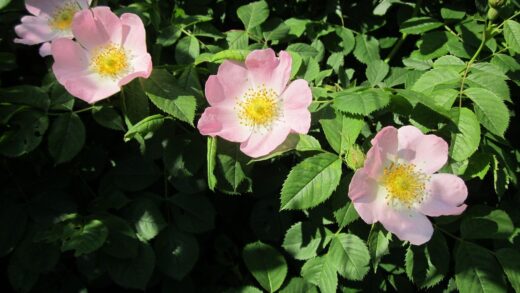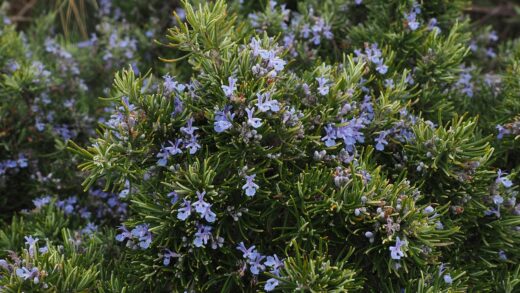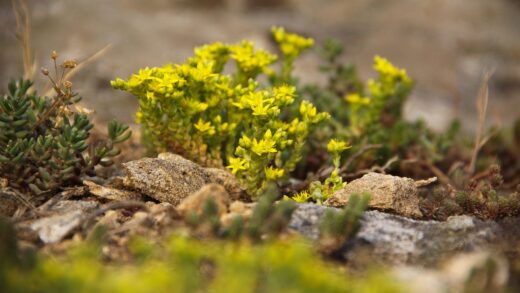While the lemon-scented geranium is a relatively robust and resilient plant, it is not entirely immune to the challenges posed by various diseases and pests. Its aromatic oils can act as a natural deterrent to some insects, but a vigilant gardener must remain aware of the potential threats that can compromise the plant’s health and vitality. Proactive care, centered on providing optimal growing conditions, is the most effective defense. A healthy, well-cared-for plant is inherently more resistant to infestations and infections than one that is stressed by poor light, improper watering, or inadequate nutrition.
The most common issues affecting these plants are often directly related to their environment. Fungal diseases, for instance, thrive in conditions of high humidity, poor air circulation, and overly wet soil. Pests are more likely to attack plants that are weakened or grown in monocultures where predators are scarce. Therefore, the first line of defense is always prevention: ensuring good spacing between plants, watering the soil instead of the foliage, and maintaining a clean growing area free of debris and dead leaves where pathogens and pests can harbor.
Regular inspection is a gardener’s most powerful tool for early detection. Many problems can be managed easily if caught before they become widespread. This involves taking the time to look closely at the plant, checking the undersides of leaves, the stems, and the soil surface for any signs of trouble. Spotting the first few aphids or the initial patch of powdery mildew allows for a swift and targeted response, often preventing the need for more aggressive chemical treatments down the line.
Should an issue arise, it is generally best to begin with the least toxic, most environmentally friendly treatment options. Mechanical removal, biological controls, and organic sprays like insecticidal soap or neem oil are often highly effective when applied correctly and diligently. A measured, integrated pest management approach not only resolves the immediate problem but also helps to maintain a healthy and balanced garden ecosystem. This guide will explore the most common adversaries of the lemon-scented geranium and provide practical strategies to keep your plant thriving.
Common fungal and bacterial diseases
The most prevalent and dangerous disease to affect the lemon-scented geranium is root rot, a fungal issue caused by pathogens like Pythium or Phytophthora. This disease is almost exclusively the result of overwatering and poorly draining soil. The roots, deprived of oxygen in the waterlogged conditions, begin to decay, turning brown, soft, and mushy. Above ground, the plant may exhibit symptoms such as wilting, yellowing of the lower leaves, and a general failure to thrive, which can often be mistaken for underwatering, leading the gardener to apply even more water and exacerbate the problem.
More articles on this topic
Botrytis blight, also known as gray mold, is another common fungal disease, particularly in cool, damp, and humid conditions. It appears as a fuzzy, grayish-brown mold on leaves, stems, and flowers, causing them to rot and decay. The spores of the Botrytis fungus are widespread and typically attack dead or dying plant tissue first before spreading to healthy parts. To prevent botrytis, it is crucial to ensure good air circulation around the plant, avoid overhead watering, and promptly remove any spent flowers or dead leaves.
Bacterial leaf spot, caused by pathogens like Xanthomonas, can also be an issue. This disease presents as small, water-soaked spots on the leaves, which may enlarge and turn brown or black, often with a yellow halo. The spots can eventually merge, leading to large areas of dead tissue and leaf drop. Bacterial diseases are spread by splashing water, so it is vital to water the soil at the base of the plant and avoid wetting the foliage. If an infection is detected, remove the affected leaves immediately to prevent its spread.
Powdery mildew is a fungal disease that is easily recognizable by the white, powdery patches it forms on the surface of the leaves and stems. While it may not kill the plant outright, it is unsightly and can weaken the plant by interfering with photosynthesis. Powdery mildew tends to be a problem in conditions of high humidity and moderate temperatures. Improving air circulation, increasing light exposure, and, if necessary, treating with horticultural oil or a potassium bicarbonate solution can help to manage and prevent this disease.
Identifying and managing common pests
Aphids are one of the most common pests you might find on a lemon-scented geranium. These small, pear-shaped insects can be green, black, or yellow and typically congregate in clusters on new growth, flower buds, and the undersides of leaves. They feed by sucking sap from the plant, which can lead to distorted growth, yellowing leaves, and a sticky residue known as honeydew, which in turn can attract sooty mold. For small infestations, a strong jet of water can be enough to dislodge them, or they can be wiped off by hand.
More articles on this topic
Whiteflies are another sap-sucking pest that can become a nuisance, especially in greenhouse environments or on indoor plants. These tiny, moth-like insects will fly up in a cloud when a plant is disturbed. Like aphids, they feed on plant juices and excrete honeydew, causing similar damage such as yellowing and stippling on the leaves. Yellow sticky traps can be very effective at monitoring and controlling adult whitefly populations. For heavier infestations, repeated applications of insecticidal soap or neem oil are necessary, ensuring thorough coverage of the leaf undersides where they congregate.
Spider mites are a particularly troublesome pest, especially in hot, dry conditions. These tiny arachnids are difficult to see with the naked eye, but their presence is often indicated by fine webbing on the plant and a stippled, silvery, or bronzed appearance on the leaves. They thrive in dry air, so increasing the humidity around the plant can help to deter them. A thorough spraying with horticultural oil or insecticidal soap is the most effective treatment, as it smothers the mites and their eggs.
Fungus gnats are small, dark flies that are often seen hovering around the soil of houseplants. While the adult flies are primarily a nuisance, their larvae, which live in the top few centimeters of moist soil, can cause damage by feeding on the plant’s roots and tender stem tissue. The key to controlling fungus gnats is to manage soil moisture. Allowing the soil to dry out thoroughly between waterings creates an inhospitable environment for the larvae. Using yellow sticky traps can capture the adults, and a soil drench with a product containing Bacillus thuringiensis israelensis (Bti) can effectively eliminate the larval stage.
Integrated pest management strategies
Integrated Pest Management (IPM) is a holistic and sustainable approach to dealing with pests and diseases that prioritizes long-term prevention over chemical intervention. The foundation of IPM is creating a healthy growing environment that makes plants less susceptible to attack in the first place. This includes choosing the right planting location with adequate sun and air circulation, using well-draining soil to prevent root diseases, and providing appropriate water and nutrition to keep the plant vigorous and resilient.
Regular monitoring is a core principle of IPM. By inspecting your plants frequently and carefully, you can identify potential problems at a very early stage. This early detection allows for the use of simple, non-chemical control methods before a pest population explodes or a disease takes hold. Hand-picking larger pests, wiping away aphids with a cloth, or pruning off a single leaf showing signs of bacterial spot are all effective early interventions that can prevent a minor issue from becoming a major crisis.
When intervention is necessary, IPM advocates for a tiered approach, starting with the least harmful methods. Mechanical and physical controls are the first choice; these include using water sprays, sticky traps, or creating barriers. If these methods are insufficient, the next step is to consider biological controls, such as introducing or encouraging beneficial insects like ladybugs, which prey on aphids, or predatory mites that control spider mites. This approach works with nature to restore a healthy balance in your garden.
The use of pesticides, even organic ones, is considered a last resort in an IPM strategy. If chemical intervention is required, select the least toxic option available, such as insecticidal soaps, horticultural oils, or neem oil, which have a lower impact on beneficial insects and the environment. Apply these products carefully, targeting only the affected areas of the plant, and always follow the label instructions precisely. The goal of IPM is not to eliminate every single pest but to manage their populations to a level where they do not cause significant damage.
Creating a healthy plant environment
One of the most effective strategies for preventing diseases and pests is to foster a healthy environment where your lemon-scented geranium can thrive. Good air circulation is paramount. Avoid overcrowding your plants; ensure there is adequate space between them to allow air to move freely. This helps the foliage to dry quickly after watering or rain, drastically reducing the likelihood of fungal diseases like botrytis and powdery mildew taking hold. For indoor plants, a small oscillating fan can be used to improve air movement.
Proper watering technique is another cornerstone of a healthy environment. As previously discussed, lemon-scented geraniums are highly prone to root rot from overwatering. By using well-draining soil and allowing the medium to dry out between thorough waterings, you create conditions that are inhospitable to the fungal pathogens that cause this devastating disease. Always water the soil directly and avoid wetting the leaves, as damp foliage is an open invitation for many bacterial and fungal infections to develop.
Maintaining good garden hygiene is a simple yet crucial preventative measure. Regularly remove and dispose of any dead or yellowing leaves, spent flowers, and other plant debris from around the base of the plant and from the soil surface. This material can harbor fungal spores and provide a hiding place for pests and their eggs. Keeping the growing area clean removes these potential sources of infestation and infection, contributing significantly to the overall health of your plant.
Finally, a well-nourished plant is a more resistant plant. Providing a balanced fertilization program during the active growing season ensures the plant has the necessary resources to build strong cell walls and produce the chemical compounds that can deter pests. However, it’s important to avoid excessive nitrogen fertilization. High levels of nitrogen can produce lush, soft growth that is particularly attractive and vulnerable to sap-sucking insects like aphids. A balanced approach to nutrition is key to building a naturally resilient plant.
Organic and chemical treatment options
When preventative measures are not enough and treatment becomes necessary, it is wise to start with organic and less toxic options. Insecticidal soap is a versatile and effective treatment for many soft-bodied pests like aphids, whiteflies, and spider mites. It works by disrupting the insects’ cell membranes and must be sprayed directly onto the pests to be effective. It has no residual effect, meaning it is safer for beneficial insects once it has dried.
Neem oil is another excellent organic option that acts as a broad-spectrum insecticide, miticide, and fungicide. It works in multiple ways: as a repellent, an antifeedant, and a growth regulator that disrupts the pest’s life cycle. It can be effective against powdery mildew and other fungal diseases as well as a wide range of pests. When using neem oil, it is important to apply it in the early morning or evening to avoid the risk of leaf burn in direct sunlight.
For fungal diseases like powdery mildew, a simple homemade spray made from potassium bicarbonate can be very effective. Mix one tablespoon of potassium bicarbonate and half a teaspoon of liquid soap (as a spreader-sticker) into four liters of water. This solution works by changing the pH of the leaf surface, making it inhospitable for the fungus to grow. Commercial fungicides based on sulfur or copper are also available for more persistent fungal problems, but these should be used with caution and strictly according to the label.
In situations with severe and persistent infestations that do not respond to other treatments, synthetic chemical pesticides may be considered as a last resort. If you choose to use them, it is crucial to identify the specific pest accurately and select a product that is labeled for that pest and for use on geraniums. Always follow the manufacturer’s instructions for mixing, application, and safety precautions, including wearing appropriate protective gear. To minimize harm to pollinators, never spray when the plant is in flower or when bees are active.


















